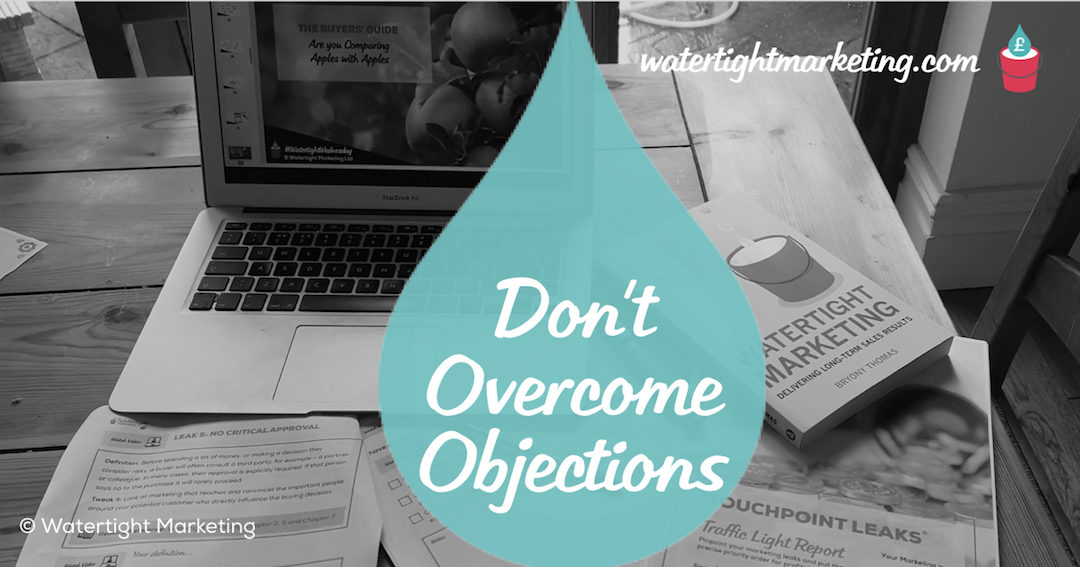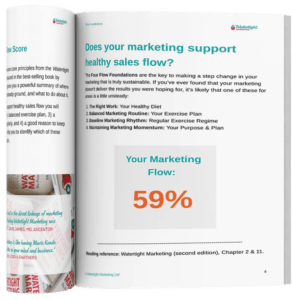Reading Time: 8 Minutes
It’s received wisdom amongst many sales professionals that a key part of their role is to overcome the objections that people may have to buying what they have on offer. Indeed, many a training session and book can be found on the skills involved in ‘objection handling’. In writing the second edition of Watertight Marketing (publication :March 2020), I revisited Leak 5 – No Critical Approval – to look at where this might fit in relation to your marketing tools. ~ Bryony Thomas, Author | Watertight Marketing
Prefer to listen than to read?
This post is also available over on our PodBlog
Leak 5 in the Thirteen Touchpoint Leaks looks in detail at the Evaluation and Trial part of the buying decision – and particularly at the ‘Voices of Veto’ that exist somewhere at this stage. These voices are those that can stop a potential sale in its tracks. Most obviously they are the friends, family or colleagues of your buyer. For example, a spouse, a parent, a coach, or boss. More subtly, these voices can be conflicting perspectives within a person’s own mind. In either scenario, it’s useful to look at what happens when these voices are not in favour of the purchase decision continuing. The voices that do not want the potential buyer to buy from you.
Does ‘Overcoming Objections’ serve a long-term relationship?
In many a sales methodology, this is where the ‘Objection Handling’ would fit. Like with so much received wisdom in the sales & marketing world… I just don’t see it like this. Now, I used to participate in competitive debates, where deconstructing an opponent’s argument was very much the aim. It was sport to identify the weaknesses in their argument and to counter it with more compelling logic, better evidenced claims, or an emotional appeal that defeated their point. This is great in a debating competition… but, is it effective in the relationship-building context of securing the trust of a long-term customer?
- Obstacles need to be overcome.
- Problems need to be handled.
Do you want your customers to consider that you see them, or their trusted inner circle, as obstacles or problems? I suspect not.
Might it be more effective to ‘Validate Concerns’ instead?
The approach I’ve developed to this, and captured within the tweaks to this marketing leak, is to Validate Concerns. The rationale is based on a number of lines of thought:
- Most third parties who have an opinion about a purchase decision at this stage in the process have the best interests of the buyer in mind.
- Their opinion makes complete sense from their perspective.
- Nobody likes being told that they’re wrong.
1) Raising concerns with the best of intentions…
When someone who’s considering buying from you thinks it through in their own mind, consults someone they trust, or seeks approval up the line, this is almost always a way of ensuring that they make a decision that’s right for them (or the organisation). This means that any concerns raised in this context almost certainly have the best interests of the buyer in mind. It can be extremely useful to think clearly about two things here:
- Is it truly in every potential buyer’s interest to buy from you? There really are times when the answer to this question is no.
- Are there genuinely good reasons that a third party identify that makes buying from you the wrong decision? Again, this may actually be the case, and it is often true that these third parties may know your buyer, or their context, better than you.
2) Concerns may make sense from their perspective…
Having thought of those concerns with which you may agree, think then about those that don’t make sense to you. Anything where you think a buyer is playing a false scenario in their mind, or consulting people who have their facts wrong, needs closer examination. Here, the task that best informs a marketer, is to take the perspective in which these concerns would appear valid. Ask yourself how a reasonable and well-intentioned person would have reached this conclusion.
3) Nobody likes to be told that they’re wrong…
Have a quick think about how you feel when you’re told that something you truly believe is wrong. Or, how you felt if you’d worked hard on something at school or college, but got a poor mark. Most humans will feel rubbish in these circumstances. In fact, many will feel shame, anger, despair, or vulnerability. I’m willing to bet that these are not the feelings you want a potential buyer, or the people who have their trust, to feel about you or your products. Finding a way to make them feel validated and respected is what you’re after here.
How to Validate Concerns with great marketing content
With these three things in mind, let’s look at how you can create marketing content that supports a salesperson or self-guided buying decision by Validating Concerns rather than Overcoming Objections.
Our key framework for doing this is by creating a Buyers’ Guide. Essentially, this is a well-written discussion or guide that helps someone to do the following things:
- Assess their true context in relation to what they are buying. If it is not right, it’s better that they know this now.
- See the scenarios in which proceeding with the purchase may not be the right decision. If there are things abut which you are not aware that make this true, it’s best to get these raised sooner rather than later.
- Consider all the likely questions they, or someone they trust, may reasonably ask (including those they may not immediately think of) and walk them through a true and evidenced answers that are respectful of anyone who may take a different perspective. Walking through multiple lines of questioning gets people to a much more committed end-decision (either by way of rational thought, or by enabling them to post-rationalise a decision already made).
Once you have this cornerstone content, you can use it is a number of highly effective ways. Whilst not an exhaustive list, here are the most popular ways we see client using this:
- Train your salespeople on the content and how to use it in meetings to validate the concerns that arise, and invite people to walk through the decision from a number of perspectives.
- Publish it as a downloadable paper or ebook
- Cut it up into blogs, vlogs, and social one-liners
- Repurpose these into articles for the press titles that reach the third parties that your buyer is likely to consult.
- Use it to create a workshop pack, or unbranded cut & paste content, that your champion can use internally with their family, peer group or colleagues.
Are we just playing with words here?
Some readers may see this as a simple case of semantics. But, I happen to think that the language we use about the techniques that we choose is extremely important. I know, without doubt, that many a sales guru will read this and say that what I’ve described IS Objection Handling with a different name. To those people, I would reply that labels matter. Language changes mindsets. And, the mindset that I’ve seen most effective in securing long-term customer relationships is not one of winning the argument, but of reaching mutual agreement.
© Watertight Marketing Ltd

Bryony Thomas
Author & Founder, Watertight Marketing
Bryony Thomas is the creator of the multi-award winning Watertight Marketing methodology, captured in her best-selling book of the same name. She is one of the UK's foremost marketing thinkers, featured by the likes of Forbes, The Guardian, Business Insider and many more, and in-demand speaker for business conferences, in-house sales days and high-level Board strategy days.



Bryony,
Great data. But, your designer is creating barriers to reading. Some of the type is so light that it is hard to read. Scroll up. Who thought that light turquoise against white was readable by anyone older than 18 who doesn’t eat carrots all day? Even this is a shade of light gray against a lighter shade a gray. When did readability become out of fashion? You have great information. Don’t let design be your undoing.
Thanks Richard. Funnily enough we have an accessibility review of both of our sites coming up, as we’re aware that it’s not ideal at the moment. Thank you for taking the time to give this feedback. Much appreciated.